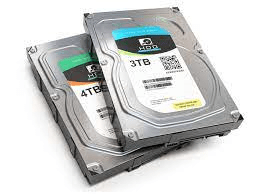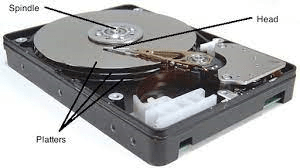What is Hard Disk Drive (HDD)?
HDD is an electro-mechanical device that enables the user to store data for future use. The device has magnetic storage that is responsible for storing the information. And, this stored information can be accessed later on; that's why it is considered non-volatile storage.

HDD is an abbreviation for Hard Disk Drive, and it is already installed in the computer when the user purchases it. The HDD is attached with the disk controllers available on the motherboard. The motherboard is the functional unit in the Central Processing Unit (CPU). Most of the data is stored in the HDD, and including the Operating Software and all the other software installed on the system. The user can also store additional computer files such as images, videos, games, etc.
The term non-volatile means that the data is permanent and won't be lost even when the computer is turned off. In 1956, HDD launched the first HDD in the market. It is a fixed device, which means a fixed amount of storage available on the disk. The first computer equipped with a hard drive had storage of less than 1Mb, but the hard drive used now can store up to 1 terabyte of data. The user can also increase the system's storage by attaching an external hard drive to the PC. This is generally used to create backup and provide extra space.
Components of Hard Disk Drive (HDD)
A Hard Disk Drive usually consists of two types of electric motors. It has a spindle motor responsible for rotating the disk and an actuator motor that sets the write/read assembly across the spinning disks, ensuring that the data can be effectively read or written on the memory. The two motors perform different functions.

An external rotor is placed to the disk in the disk motor and has stator windings. The windings are attached to a place. At the opposite end of the actuator is the head of the support arm. It has multiple read/write pins on it. They have printed circuits attached to these heads that are responsible for amplifying the signals from the electronic devices placed above the actuator motor's pivot. They are made light weighted but stiff at the same time.
The new hard disk drives can be accelerated up to 550g. The actuator motor constitutes a permanent magnet, and enclosed between the magnet is a moving coil used to position the heads and place them to the required position. It also has a metallic plate that supports a squat NIB high flux magnet. The moving coil is placed just below the plate. The coil is also referred to as a voice coil. The coil is connected with the actuator hub, and a second permanent magnet is below it. It is attached to the bottom of the motor plate. While most the HDDs have two magnets, there are some which may have only one magnet.
The voice coil is designed like an arrowhead and is covered with magnetic copper wires on all sides. It is done so that it can be wounded in different shapes without breaking the wire. It also ensures that the wire does not require any external support. The inner coating is made up of an insulating material, and the outermost layer is made up of thermoplastics.
The coil and the arrowhead's sides are suspended in the magnetic field produced by the magnets. The current is passed to the copper wire wrapped around the arrowhead. The direction of the current is radially outward from one side while it is radially inward on the opposite side. The electric current and the magnetic field produce a tangential force. If the magnetic field is kept constant, the force generated from both ends will be equal in magnitude but opposite in direction. There will be no effective force. This will lead to no output. Therefore, the polarity at both ends is kept exactly opposite. That means if one side is the north pole, the other end is the south pole of the same magnet with a radial division. This ensures that the forces add instead of getting cancelled out. The force produced when current is passed from the top of the coil to the other is radial in direction. This does not rotate the head.
The electronic control is responsible for causing the movements in both motors. The disk controller instructs the motor about what and when the data will be read or written from the disk. It is important that both the motor is properly working so that data can be correctly written and read for the memory.
The feedback from the device is provided by using dedicated segments for the disk.
Furthermore, in server technology, they are concentric circles with real data. The feedback improves the quality of the data stored in the drive-by, managing the signal-to-noise ratio. It can also do so by simply adjusting the voice coil attached to the actuated arm. A Servo motor is also used for the rotation of the disk. The new versions of HDD can schedule the read and write operation effectively on the platter surfaces. It also remaps the media sector that was not properly stored in the first attempt.
Error Detection and Handling
Modern HDD implements an error correction code (ECC). The technique for error correction is called Reed-Solomon Error Connection. In this, some additional bits are added, and these additional bits are computed using a mathematical formula. For every block of data, the error can be resolved by those bits invisibly. They occupy the space on the drive itself. It prevents the uncorrectable error from occurring. Extra space other than the storage to handle these additional bits of data.
For example: If the storage of the hard disk is 1 Tb that has 512-byte sectors, then it may have additional storage up to 93 Gb for the error correction codes only. In the latest hard drives, these ECC were supplanted by the low-density parity-check codes as they provide better performance and high storage density.
Distinguish Between Hard Disk Drive and Solid-State Drive
| HDD | SSD |
| 1. HDD stands for Hard Disk Drive. | 1. SSD stands for Solid State Drive. |
| 2. It requires comparatively more time to perform read or write operations on the data stored in HDD. | 2. It requires comparatively less time to perform read or write operations on the data stored in SSD. |
| The latency is very high in the HDD. | 3. The latency in the SSD is comparatively low. |
| 4. The HDD can only perform very few input and output operations in a limited time. It only supports limited operations. | 4. The user can perform multiple input and output operations in a second. |
| 5. The HDD consists of a rotating disk and a motor; these components add to the weight of the HDD and make it quite heavy. | 5. The SSD does not have a rotating disk or a motor resulting in comparatively less weight. |
| 6. In the HDD, the data is received and sent in sequential order. | 6. In the SSD, the data is not sent or received sequentially. |
| 7. When the data is written or read from the HDD, a mechanical movement is performed by the disk and the motor that produces noise. | 7. The storage does not involve any mechanical moment and does not produce much noise. |
| 8. The Hard Disk Drive is larger in size. | 8. It requires fewer parts making SSD compact. |
| 9. HDD is cheaper than SSD. | 9. SSD is more expensive as compared to HDD. |
| 10. It uses an electromagnet to store the data; it can be affected using a magnet, resulting in data loss if kept near a strong magnet. | 10. A magnet does not affect the data stored inside the SSD. |
| 11. The movement of the motor and disk produces a lot of heat. | 11. There is no mechanical movement required to read or write the data, so very little heat is produced in SSD. |
| 12. HDD consumes more energy as it requires more electrical energy to perform those mechanical movements. | 12. It requires very less energy. |
| 13. The time required to perform a boot on HDD is about 30-40 seconds. | 13. It is more efficient as it requires only 10-13 seconds to perform a boot on SSD. |
| 14. It takes more time to open the file on HDD. | 14. It is more efficient, and the processing speed is high; it is 30% faster than the HDD. |
| 15. The mechanical motion causes vibrations. | 15. Without any moving parts, there are no vibrations. |
Advantages of Using HDD
- The HDD is used extensively in personal computers for providing storage.
- Its cost significantly less, which means this reduces the total cost of the production of the computer.
- They are easily available in the market. The user can purchase them from the market to increase the storage or replace the existing ones.
- They are more efficient than optical disks and provide large storage to the user.
Disadvantages of Using HDD
- As the capacity to store the data increases, it reduces the speed of processing.
- Due to all the mechanical movement, it produces a lot of noise.
- It is not energy efficient.
- Also, it is heavy; thus, it increases the weight of the system.